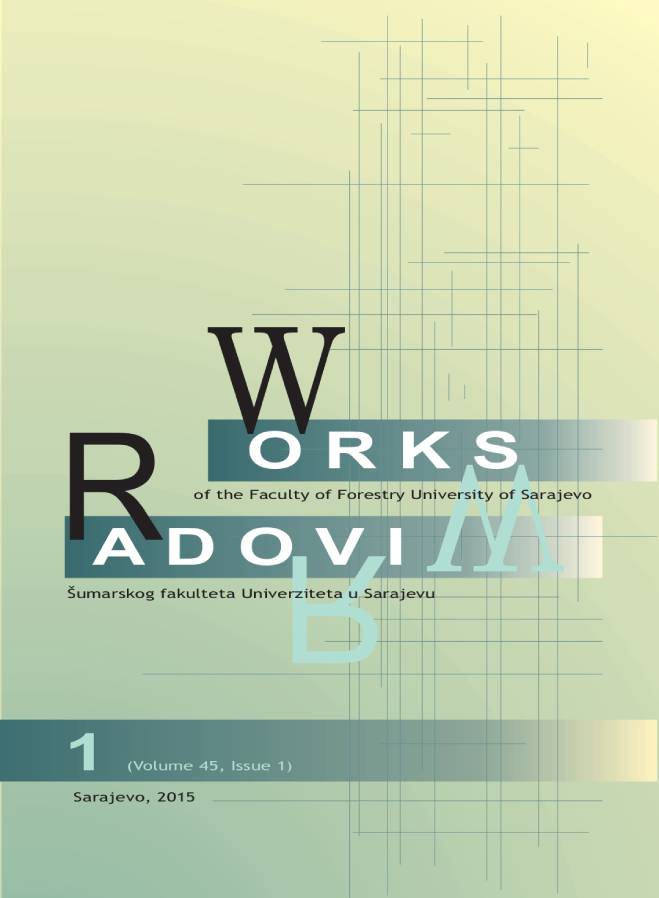COMPARISON OF POLYPHENOL CONTENT AND ANTIOXIDANT ACTIVITY OF EXTRACTS FROM FRUITS OF TWO CRATAEGUS SPECIES
DOI:
https://doi.org/10.54652/rsf.2015.v45.i1.93Keywords:
C. monogyna, C. rhipidophylla, phenols, DPPHAbstract
UDK: 547.56:582.711.714(234.422 Trebević)
Methanolic and acidified methanolic extracts of C. monogyna and C. rhipidophylla dried fruits were used in estimation of total phenolic contents and antioxidant activities. The extracts of fruit were examined for their antioxidant activity by DPPH method. Antioxidant activity of the extracts varied from 17.65 to 22.05 mg ascorbic acid equivalents per g-1 dry weight. Total phenols, flavonoids, monomeric anthocyanins and proanthocyanidins in fruits ranged from 21.53 to 34.72 mg gallic acid equivalents per g-1 dry weight, 0.75 to 1.92 mg rutin equivalents and 0.13-0.93 mg quercetin equivalents per g-1 dry weight, 0.51 to 0.82 mg cyanidin-3- glucoside equivalents per g-1 dry weight, 11.27-18.77 mg cyanidin chloride equivalents per g-1 dry weight respectively. The higher values of total flavonoids generally are obtained with 80% methanol extracts for both species.
The amounts of all investigated compounds and antioxidant activity were significantly higher in C. monogyna fruits which were confirmed by one-way ANOVA analysis. Correlations between antioxidant activity and total phenols and proanthocyanidin contents were found as the main compounds influencing the antioxidant capacity of the samples. Obtained results suggest that both species represent valuable source of antioxidant compounds.
Downloads
References
ANDERSEN, Q.M. AND JORDHEM, M. (2006): The anthocyanins. IN Q.M. Andersen and K.R. Markham (Eds), Flavonoids: Chemistry, biochemistry and applications, CRC, Taylor&Francis, Boca Raton, p. 472-537.
BAHRI-SAHLOUL, R., AMMAR, S., GREC, S., HARZALLAH-SKHIRI, F. (2009B): Chemical characterization of Crataegus azarolus L. fruit from 14 genotypes found in Tunisia. Journal of Horticulture Science of Biotechnology, 84, 23-28.
BAHORUN, T., TROTIN, F., POMMERY, J., VASSER, J., PINKAS, M. (1994): Antioxidant activities of Crataegus monogyna Extracts. Planta Medica, 60: 323-328.
BARROS, L., CARVALHO, A.M., FERREIRA, I.C.F.R. (2010): Comparing the composition and bioactivity of Crataegus monogyna flowers and fruits used in folk medicine, Phytochemical Analysis. 22, 181–188.
BAŠIĆ, N. (2004): Morfološko-taksonomska istraživanja glogova (Crataegus L.) na području Bosne i Hercegovine. Magistarski rad. Sarajevo.
BECK, G. (1927): Flora Bosne, Hercegovine i oblasti Novoga Pazara. III . Choripetalae (Kaj): 169-172. Beograd-Sarajevo
BERNATONIENE, J., MASTEIKOVA, R., MAJIENE D., SAVICKAS, A., KEVELAITIS, E., BERNATONIENE, R., DVORAČKOVA, K., CIVINSKIENE, G., LEKAS, R., VITKEVIČIUS, K., PEČIURA, R. (2008): Free radical-scavenging activities of Crataegus monogyna extracts. Medicina (Kanaus), 44(9).
CHANG, Q., ZUO, Z., HARRISON, F., CHOW, M.S.S., (2002): Hawthorns: An overview of chemical, pharmacological and clinical studies. Journal of Clinical Pharmacology. 42, 605-612.
THE COUNCIL OF EUROPE (2004): European Pharmacopoeia, fifth ed. Edqm, Strasbourg, pp. 1712-1715.
CHRISTENSEN, K. I., JANJIĆ, N. (2006): Taxonomic notes on European taxa of Crataegus (Rosaceae). Nordic Journal of Botany, 24: 143-147.
DEWICK, P.M. (2009): Medicinal natural products: A biosynthetic approach. John Wiley & Sons LTd., Chichester, SXW, UK.
DAİ, J. AND R. L J. MUMPER (2010): Plant Phenolics: Extraction, Analysis and Their Antioxidant and Anticancer Properties. Molecules, 15, 7313-7352.
EGEA, I., SANCEZ-BEL, P., ROMOJARO, F., PRETEL, MT. (2010): Six edible wild fruits as potential antioxidant additives or nutritional supplements. Plant Foods Human Nutrition 65:121-129.
FONG, H.H.S. AND BAUMAN, J.L. (2002): Hawthorn. Journal of Cardiovascular Nursery, 16, 1-8.
FROEHLICHER, T., HENNEBELLE, T., MARTIN-NIZARD, F., CLEENEWERCK, P., HILBERT, JL., TROTIN, F. (2009): Phenolic profiles and antioxidative effects of hawthorn cell suspensions, fresh fruits and medicinal dried parts. Food Chemistry, 115, 897- 903.
FUKAREK, P. (1974): Neke vrste drveća i grmlja koje su pogrešno navedene u Flori Bosne i Hercegovine i susjednih krajeva. ANU BiH-Radovi LIV, Odjeljenje prirodno-matematičkih nauka, 15: 45-60.
JANJIĆ, N. (1998): Neki zanimljivi dendrološki nalazi iz sarajevskog područja. Radovi Šumarskog Fakulteta Univerziteta u Sarajevu, 28(1): 85-103.
JANJIĆ, N. (2002): Nova kombinacija u lepezolisnog ili krivočašičnog gloga, Crataegus rhipidophylla Gand. (Rosaceae). Radovi Šumarskog Fakulteta Univerziteta u Sarajevu, 32(1): 1-7.
KHODDAMI, A., WILKES, M. A. & ROBERTS, T. H., (2013): Techniques for Analysis of Plant Phenolic Compounds. Molecules 2013, 18, 2328-2375.
KIM, S.H., KANG, K.W., KIM, K.W., KIM, N.D. (2000): Procyanidins in Crataegus extract evoke endothelium-dependent vasorelaxation in rat aorta. Life Science, 67:121-131.
LEE, J., DURST, RW., WROLSTAD, E. (2005): Determination of total monomeric anthocyanin pigment content of fruit juices, beverages, natural colorants, and wines by pH differential method: Collaborative study. Journal of AOAC International, 88(5), 1269-1278.
MALÝ, K. (1919): Prilozi za floru Bosne i Hercegovine 5 i 6. Glasnik Zemaljskog Muzeja BiH, Sarajevo, 31: 61-92.
MALÝ, K. (1940): Notizen zur Flora von Bosnien-Herzegovina. Glasnik Zemaljskog Muzeja BiH, Sarajevo, 52: 21-46.
MRAIHI, F., JOURNI, M., CHERIF, JK. SOKMEN, M., SOKMEN, A., TRABELSI-AYADI, M. (2013): Phenolic content and antioxidant potential of Crataegus fruits grown in Tunisia as determined by DPPH, FRAP, and β-carotene/linoleic acid assay. Journal of chemistry, volume 2013, 1-6.
ORDONEZ, A.A., GOMEZ, J.G., VATTUONE, M.A. AND ISLA, M.I. (2006). Antioxidant activities of Sechium edule swart extracts. Food Chemistry, 97: 452-458.
PIETTA, P.-G. (2000): Flavonoids as antioxidants. Journal of Natural Products. 63, 1035
PORTER, L.J., HRSTİCH, I.N., & CHAN, B.G., (1986): The conversion of procyanidins and prodelphinidins to cyaniding and delphinidin, Phytochemistry, 25, 1, pp. 223-230.
QUETTIER, DC., GRESSIER, B., VASSEUR, J., DINE, T., BRUNET, C., LUYCK, MC., CAYIN, JC., BAILLEUL, F., TROTIN, F. (2000): Phenolic compounds and antioxidant activities of buckwheat (Fagopyrum esculentum Moench) hulls and flour. Journal of Ethnopharmacology, 118, 418-428.
RUIZ-RODRIGEZ, B., DE ANCOS, B. SANCEZ-MORENO, C., FERNANDEZ-RUIZ, V., SANCEZ-MATA, M., CAMARA, M., TARDIO, J. (2014). Wild blackthorn (Prunus spinosa L.) and hawthorn (Crataegus monogyna Jacq.) as valuable source of antioxidants. Fruits, 69, 61-73.
SANCEZ-MORENO, C., LARRAURI, J.A., SAURA-CALIXTO, F. (1998): A procedure to measure the antiradical efficiency of polyphenols. Journal of Science Food Agriculture, 76, 270-276.
SINGLETON, V.L., ORTHOFER, R., LAMUELA-RAVENTOS, R.M. (1974): Analysis of total phenols and other oxidation substrates and antioxidants by means of Folin-Ciocalteu reagent. Methods of Enzymology, 229, 152-178.
TAHIROVIĆ, A. AND BAŠIĆ, N. (2014): Phenolic content and antioxidant activity of Crataegus monogyna Jacq fruit extracts. Works of the faculty of Forestry University of Sarajevo, 44(2), 29-40.
ZHANG, Z., CHANG, Q., ZHU, M., HUANG, Y., HO, W.K.K., CHEN, Z.-Y. (2001): Characterization of antioxidants present in hawthorn fruits. Journal of Nutritional Biochemistry, 12, 144.






















